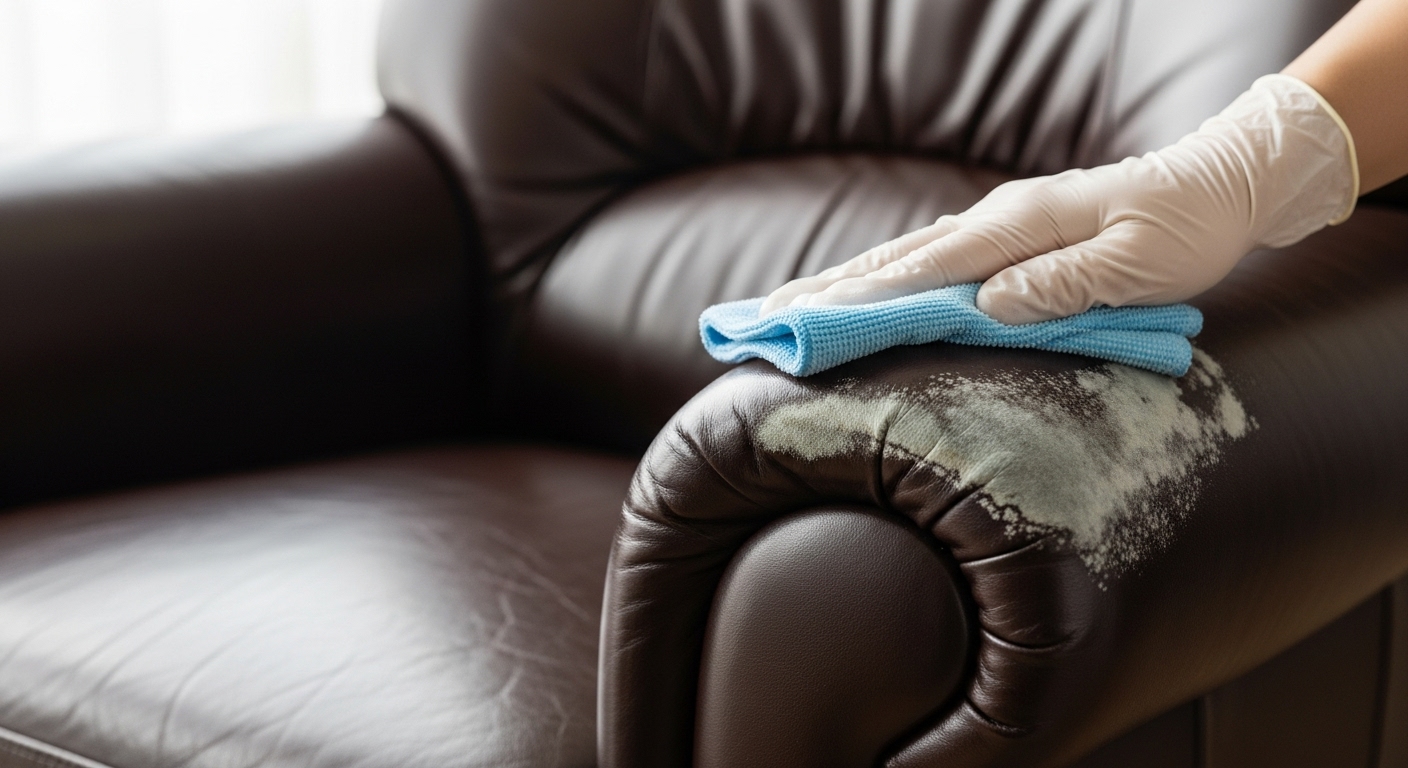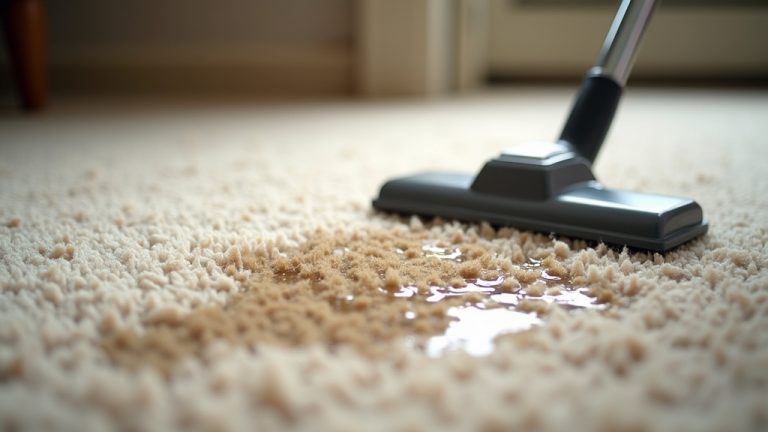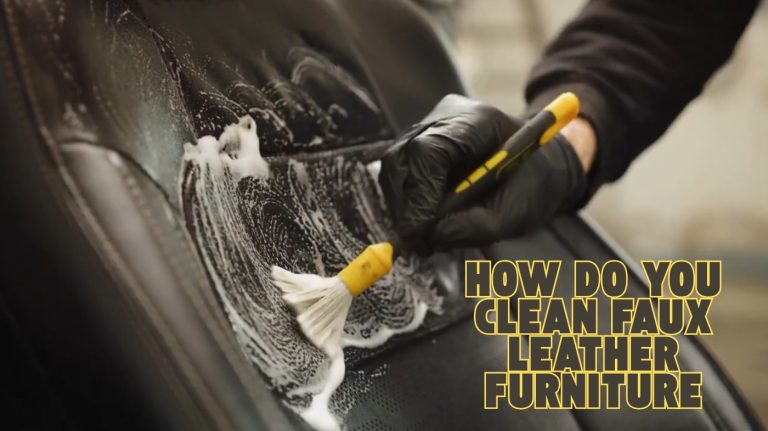How to Clean Mildew from Leather Furniture? Easy, Safe Steps
To clean mildew from leather furniture, first work in a well-ventilated, low-humidity area and wear protective gear to avoid spores.
Gently brush off loose mold with a soft brush outdoors. Apply a solution of equal parts rubbing alcohol and water using a soft cloth, testing it first on a hidden spot.
Avoid saturating the leather, then blot dry and air out completely. Condition the leather once dry to prevent cracking. For thorough care and prevention, keep exploring effective drying and maintenance strategies.
Key Takeaways
- Clean leather in a well-ventilated, low-humidity area using gloves and a soft brush to remove loose mold spores gently.
- Apply equal parts rubbing alcohol and water with a soft cloth in circular motions, then lightly rinse without soaking the leather.
- Test cleaning solutions like diluted oxygen bleach or white vinegar on hidden spots to ensure leather safety before full application.
- Air dry leather away from sunlight and heat, using fans or dehumidifiers, and blot moisture with a soft cloth.
- Condition the leather after drying with a quality leather conditioner to restore moisture and prevent future mold growth.
Preparing Your Leather Furniture for Mold Removal
Before you begin removing mildew from your leather furniture, it’s essential to prepare both the environment and the leather surface properly.
Choose a well-ventilated area with low humidity—ideally below 50%—to reduce airborne mold spores and moisture. Avoid basements or attics and keep the space free from direct sunlight and heat sources, which can dry out and damage leather.
Because leather’s porous structure absorbs moisture and nutrients, creating ideal conditions for mould, controlling the environment is crucial. Using proper ventilation also helps speed up drying after cleaning, minimizing the chance of mildew returning.
Use dehumidifiers or moisture absorbers to maintain ideal conditions. On the leather, gently remove dust and loose spores with a soft brush or dry cloth, preferably outdoors. Vacuum with a brush attachment to extract remaining spores.
Inspect the leather for visible mold or musty odors. Lightly dampen cloths when wiping to avoid saturation. Always test cleaning products on a hidden area first to prevent discoloration or damage.
Safe Methods to Remove Mildew From Leather
When tackling mildew on leather furniture, you must prioritize safety by wearing gloves, masks, and goggles to protect against inhaling spores.
Work in a well-ventilated area or outdoors to minimize airborne exposure. Mould can cause serious health issues including skin, eyes, nose, and throat irritation, so immediate care is essential.
Before cleaning, remove nearby fabrics to prevent cross-contamination and dispose of or thoroughly clean any used materials afterward. Proper cleaning techniques are crucial as harsh chemicals or abrasive tools can damage delicate surfaces like leather.
Start by gently brushing the mildew with a soft-bristled brush or vacuum with a brush attachment, avoiding abrasive tools that could damage leather. Repeat this step as needed prior to applying any cleaning agents. Using non-abrasive tools ensures the leather’s finish remains intact and prevents further deterioration.
- Wear full protective gear during all cleaning stages
- Use soft-bristled brushes and vacuum attachments to remove spores
- Conduct cleaning outside or in ventilated spaces
- Dispose or sanitize cleaning materials after use to prevent spreading spores
Effective Cleaning Solutions for Mold Treatment
Although leather requires careful handling, you can effectively treat mold using specific cleaning solutions that target spores without damaging the material.
Start with a mixture of equal parts rubbing alcohol and cool water applied gently with a soft cloth in circular motions. Rinse lightly with a damp cloth to avoid saturation.
Using a mask and rubber gloves during cleaning helps protect you from inhaling or touching mold spores, ensuring personal safety.
Regular maintenance and proper ventilation can help prevent the return of mold by reducing moisture on the leather surface, which is crucial since moisture accelerates oxidation.
For fabric linings attached to leather, dilute oxygen bleach (two tablespoons per cup of water) applied with a cloth works well but avoid direct contact with leather.
White vinegar, diluted or full strength, offers antifungal properties and odor removal—always test in an inconspicuous area first.
Commercial leather mold cleaners like saddle soap are suitable when used according to manufacturer instructions, ensuring compatibility with your leather type. Always avoid harsh scrubbing to prevent damage.
Proper Drying and Conditioning After Cleaning
After thoroughly cleaning your leather furniture, you’ll need to dry it carefully to prevent damage and mold growth.
Start by blotting excess moisture with a dry, soft cloth and allow the leather to air dry naturally in a well-ventilated area.
Avoid direct sunlight or heat sources, which can cause cracking or warping. Prolonged exposure to moisture without proper drying can lead to cracking and dryness in the leather.
Using fans or dehumidifiers can help control humidity levels and speed up the drying process without damaging the leather.
For water-based leather, insert newspaper inside cushions to absorb internal moisture without altering shape. Once fully dry, apply a high-quality leather conditioner evenly with a microfiber cloth to restore suppleness.
- Use fans or dehumidifiers to speed drying while controlling humidity
- Never use high heat like hair dryers to dry leather
- Allow conditioner to absorb fully without wiping it off
- Condition leather at least twice yearly to maintain softness and prevent cracking
Tips for Preventing Mold Growth on Leather Furniture
Since leather is highly susceptible to moisture damage, controlling indoor humidity below 60% is essential to prevent mold growth on your furniture.
Use dehumidifiers or moisture absorbers and avoid placing leather in damp, poorly ventilated areas. Mold spores thrive in environments with excess humidity, so reducing moisture is critical.
Make certain adequate air circulation with fans or open windows to accelerate drying. Position furniture where it receives indirect natural sunlight daily, rotating it periodically to expose all surfaces without causing drying or cracking. Proper airflow conditions help prevent moisture buildup that encourages mildew.
Clean leather regularly with mild solutions and soft cloths, avoiding harsh chemicals that strip protective layers. Immediately wipe spills and use water-resistant conditioners to shield against moisture.
Incorporate natural antimicrobials like tea tree oil during conditioning. Monitor weather and adjust indoor climate controls accordingly, maintaining a vigilant routine to minimize moisture exposure and inhibit mold proliferation on your leather furniture.
Frequently Asked Questions
Can Mold on Leather Cause Health Problems?
Yes, mold on leather can definitely cause health problems. You may experience allergic reactions like sneezing or skin rashes, and respiratory issues such as asthma attacks or infections. Mold spores can become airborne during disturbance, increasing risk.
If you have a weakened immune system, symptoms might be more severe. It’s important you address mold promptly to avoid chronic respiratory conditions and skin irritations linked to prolonged exposure.
Is It Safe to Use Commercial Mold Removers on Leather?
Using commercial mold removers on leather isn’t always a walk in the park. Many contain harsh chemicals that can dry out or discolor your leather.
You should only use products specifically labeled safe for leather and test them on a hidden spot first.
Overusing strong cleaners can strip natural oils, causing cracks.
Follow manufacturer instructions closely, and when in doubt, consult a professional to avoid costly damage.
How Long Does Mold Take to Damage Leather Permanently?
Mold can permanently damage leather within 1 to 3 months if left untreated. You’ll notice initial surface stains within days, but mold breaks down collagen fibers over 2-4 weeks, causing stiffness and brittleness.
Constant moisture, warmth, and poor ventilation speed this process. If mold penetrates deeply, stains won’t clean off, and the leather becomes rough or cracked.
Act quickly to prevent irreversible structural damage and preserve your leather’s integrity.
Can Mold on Leather Spread to Other Furniture?
Oh, sure, let your moldy leather throw a wild party and invite your other furniture!
In reality, mold spores travel through air currents like uninvited guests, settling on nearby surfaces and spreading contamination.
If your space is humid or poorly ventilated, those microscopic spores will happily colonize wood, fabric, or leather alike.
Keep your furniture apart, maintain low humidity, and clean regularly to stop mold’s unwelcome expansion and protect your belongings.
Are All Types of Leather Equally Susceptible to Mold?
Not all leather types are equally susceptible to mold. You’ll find full-grain leather resists mold best due to its dense surface, while suede and nubuck, being porous, trap moisture and mold more easily.
Split leather absorbs moisture quickly, increasing mildew risk. Exotic leathers like kangaroo and stingray resist mold well thanks to their unique, dense fiber structures.
Your maintenance and environment also play critical roles in susceptibility.
Ensure Your Leather Furniture Stays Fresh and Protected
Mildew affects up to 60% of leather furniture in humid environments, making regular cleaning essential. By preparing your furniture properly and using safe, tested methods, you minimize damage while effectively removing mold.
Always dry and condition leather thoroughly to restore its integrity. Remember, preventing mold growth involves controlling moisture and maintaining airflow.
Taking these detailed steps guarantees your leather stays clean, durable, and mold-free, preserving its value and appearance over time.







